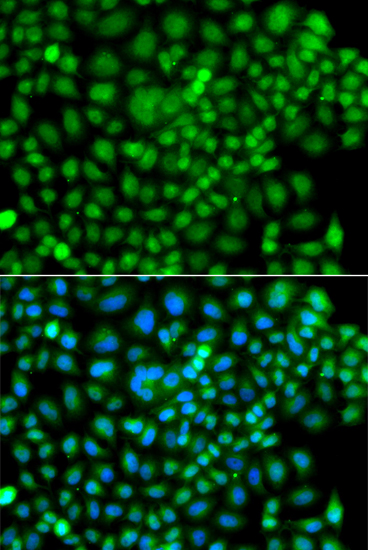-
Product Name
SUMO4 Polyclonal Antibody
- Documents
-
Description
Polyclonal antibody to SUMO4
-
Tested applications
WB, IF
-
Species reactivity
Human, Mouse, Rat
-
Alternative names
SUMO4 antibody; IDDM5 antibody; SMT3H4 antibody; SUMO-4 antibody; dJ281H8.4 antibody; small ubiquitin-like modifier 4 antibody
-
Isotype
Rabbit IgG
-
Preparation
Antigen: Recombinant fusion protein containing a sequence corresponding to amino acids 1-95 of human SUMO4 (NP_001002255.1).
-
Clonality
Polyclonal
-
Formulation
PBS with 0.02% sodium azide, 50% glycerol, pH7.3.
-
Storage instructions
Store at -20℃. Avoid freeze / thaw cycles.
-
Applications
WB 1:500 - 1:2000
IF 1:50 - 1:200 -
Validations

Western blot - SUMO4 Polyclonal Antibody
Western blot analysis of extracts of various cell lines, using SUMO4 antibody at 1:1000 dilution._Secondary antibody: HRP Goat Anti-Rabbit IgG (H+L) at 1:10000 dilution._Lysates/proteins: 25ug per lane._Blocking buffer: 3% nonfat dry milk in TBST._Detection: ECL Enhanced Kit ._Exposure time: 40s.

Immunofluorescence - SUMO4 Polyclonal Antibody
Immunofluorescence analysis of A549 cells using SUMO4 antibody . Blue: DAPI for nuclear staining.
-
Background
Ubiquitin-like protein which can be covalently attached to target lysines as a monomer. Does not seem to be involved in protein degradation and may modulate protein subcellular localization, stability or activity. Upon oxidative stress, conjugates to various anti-oxidant enzymes, chaperones, and stress defense proteins. May also conjugate to NFKBIA, TFAP2A and FOS, negatively regulating their transcriptional activity, and to NR3C1, positively regulating its transcriptional activity. Covalent attachment to its substrates requires prior activation by the E1 complex SAE1-SAE2 and linkage to the E2 enzyme UBE2I.
Related Products / Services
Please note: All products are "FOR RESEARCH USE ONLY AND ARE NOT INTENDED FOR DIAGNOSTIC OR THERAPEUTIC USE"
